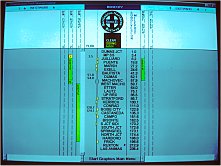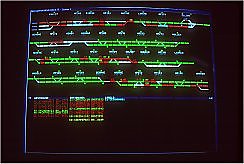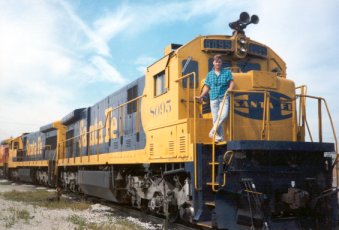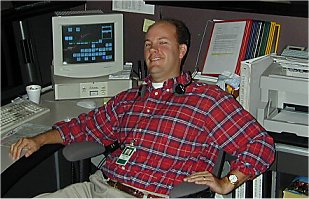Support this website by joining the Silver Rails TrainWeb Club for as little as $1 per month.
Click here for info.
This website has been archived from TrainWeb.org/southwestshorts to TrainWeb.US/southwestshorts.

|

|
| Wes Carr - Train Dispatcher |
|---|
| The other half of my railroad interest involves what I do for a living: dispatching trains for BNSF. As I mentioned, my interest in railroads and trains developed at an early age: about age 11 or so. I mentioned we lived in San Angelo; before moving there, my family lived in the central Texas town of Temple in the mid- and late-70s. It just so happened that one of our neighbors there was Santa Fe's Don McInnes, who at the time worked in Temple as a trainmaster. |

Chicago in 1987. I'm 15 years old and I've got the run of the place! Photo by Frank Kowalczyk. |
Mr. McInnes would later become one of Santa Fe's top vice-presidents prior
to the BNSF merger. Well, my parents became good friends with the McInnes
family, and Mr. McInnes was instrumental in furthering my railroad interest
by giving me an "inside" perspective.
In 1987, he arranged for me to take a tour of Santa Fe's Corwith yard while my family and I were vacationing in Chicago. Talk about a thrill! Imagine the excitement of a 15-year old railfan who was used to seeing about one train a month, given free reign to photograph each one of the dozens of locomotives on the Corwith service tracks! |
|
In 1990, following my high school graduation, I had the opportunity
to visit the Santa Fe's dispatching center in Euless, Texas. This was my
first visit to a dispatching office, and I was quite intrigued not only by
the processes used to move trains, but also just by the amount of
information at the dispatchers' fingertips: being able to see a list of the
locomotives assigned to a particular train, running a list of the train's
cars, crew information and on-duty times, hours of service, etc. Dispatching
began to look like a very interesting line of work, especially after I got
my first programmable scanner and started listening in on dispatchers' radio
transmissions on the Santa Fe Lampasas Subdivision in central and west
Texas, and on railroads in the Dallas-Ft. Worth area.
I went to college hoping (but not necessarily expecting) to work in railroading or transportation after graduation. I received my bachelor's degree in marketing from SMU's Cox School of Business in 1994. I submitted resumes to most of the larger railroad companies (and even some of the smaller ones), but was unsuccessful at even getting an interview. Thus, I ended up spending my first year after graduating working at a Kmart store in my hometown of San Angelo, going through Kmart's ambitious "management training program," a line of work which had me looking for other employment mere weeks after I started the job. Once again, I began contacting the railroads regarding employment possibilities, but this time, I was more persistent. One should never underestimate the value of having an "inside" contact at a company or industry in which he is interested in being employed. I succeeded in getting an interview during an "informational visit" to Santa Fe's Schaumburg (Illinois) headquarters in April 1995. But the Santa Fe is not where I began my railroad career. I either didn't have a good enough interview, or didn't make enough of an impression for Santa Fe to offer me a job. Or maybe I just wasn't persistent enough. |
| Fortunately, I had succeeded in contacting someone at Burlington Northern who was able to place me in contact with the manager of dispatching practices, who in turn suggested I contact Johnson County Community College (in Overland Park, KS) and inquire about their dispatcher training program, which BN sponsored. I interviewed in May, sweated it out through all of June, and finally in July, received a call stating that someone had dropped out of a dispatcher training class that was about to start, and -- if I wanted to -- I could take his place and enter the program.... which started in six days! |

BNSF El Paso desk, 1999 Photo by Keith Buckley. |
|
So with that, I quit my Kmart job on five days' notice (an
undertaking not unlike jumping off a sinking ship), packed up my apartment,
turned in my keys to the store (ironically, on the one-year anniversary of
the day I started there), and hit the road. I was in!
The BN dispatcher training program lasted just over three months, and consisted of the following: * one-week orientation and introduction to the railroad, in Kansas City * two-week terminal and mechanical training in Ft. Worth (riding switch engines and transfer jobs, working with carmen, working on the RIP track, locomotive service tracks, etc.) * one-week of maintenance-of-way training in Brainerd, MN (during which we visited an equipment repair shop and watched a steel gang work) * a week and a half of train rides, during which I rode trains from Fort Worth to Pueblo, Colorado and back * one week of dispatcher observation at the newly opened NOC in Fort Worth * three week rules (GCOR) class in Overland Park * another week of dispatcher observation * three weeks of CTC and track warrant simulation in Overland Park. Following all of that, the class took the final exam, and those of us that passed (with a grade of 90% or better) were offered jobs by the BN and began breaking in on dispatching desks in Ft. Worth. And I've been here ever since. Over the twelve years, I have dispatched the following dispatching districts and territories. The railroad has re-alligned some of the territories over the past few years, but the way I have presented them below indicates the way the jobs were set up when I first worked them: * Ottumwa: ex-CB&Q, Ottumwa Sub (Galesburg, IL to Creston, IA) and Des Moines branch (Albia to Des Moines) * Main Line: ex-CB&Q, Mendota Sub (Galesburg to Aurora), Beardstown Sub (from Bushnell to Beardstown), Peoria Sub (Galesburg to Peoria), Zearing branch (Zearing to LaSalle) and a couple other branches * Beardstown: ex-CB&Q, Beardstown Sub (Beardstown through Centralia, Il to Paducah, KY) * K Line: ex-CB&Q, Brookfield Sub (Galesburg to West Quincy, MO); Hannibal Sub (West Quincy to St. Louis) * Kansas City: ex-CB&Q, Hannibal Sub (Burlington, IA to West Quincy, MO); Brookfield Sub (West Quincy to Kansas City); also the Thomas Hill branch from Bevier to Thomas Hill * Cuba River: ex-SLSF. Cuba Sub (St Louis to Springfield) and River Sub (St Louis to just outside Memphis) * Kansas City South: ex-SLSF. Ft. Scott Sub (Kansas City through Ft. Scott, KS to Nichols, Mo -- just outside Springfield) and the Afton Sub (Ft Scott to Afton Jct, Oklahoma) * Pasco West: ex-SP&S, Wishram Sub (from Pasco, WA to Wishram), Fallbridge Sub (Wishram to Skamania) * Pasco East: ex-SP&S, Lakeside Sub ( Pasco to Spokane ); ex-NP, Yakima Valley Sub (Pasco to Ellensburg) * Centralia South: ex-NP, Seattle Sub (Vancouver, WA to Centralia) * Alliance East: ex-CB&Q. Sandhills Sub (Alliance to Ravenna, NE) * El Paso (DS19): ex-ATSF. Boise City Sub (Amarillo to Las Animas...near LaJunta, CO); El Paso Sub (Belen, NM to El Paso); Deming Sub (Rincon to Deming, NM); Carlsbad Sub (Clovis to Carlsbad, NM); and Rustler Springs Sub (Carlsbad, NM to Rustler Springs, TX) * Sheridan: ex-CB&Q / BN Big Horn Sub (Gillette to Sheridan, WY.); Dutch Sub (Dutch, WY to Decker, MT serving coal mines at East Decker, West Decker, and Spring Creek) * Front Range: ex-C&S. Front Range Sub (Denver through Cheyenne to Wendover, WY); Casper Sub (from Bridger Jct to Casper, WY); Golden Sub (Denver to Golden) * Amarillo (old): ex-FW&D. Red River Valley Sub (Estelline -- west of Childress, TX -- to Amarillo); Dalhart Sub (Amarillo to Texline) * Amarillo (current): ex-FW&D. Red River Valley Sub from Vernon TX to Amarillo. * Trinidad: ex-C&S. Twin Peaks Sub (Texline, TX to Trinidad, CO); Spanish Peaks Sub (Trinidad to Pueblo). * Avard (old): ex-SLSF. Avard Sub from Tulsa to Enid to Avard, OK, plus Creek Sub from Sapulpa (south of Tulsa) to Scullin (north of Madill, OK). * Creek: ex-SLSF. Sapulpa (south of Tulsa) to Scullin (north of Madill, OK). * Avard (current): ex-SLSF. Avard Sub from Tulsa to Enid to Avard, OK. Additionally, I have worked as Assistant Chief dispatcher on the Illinois and Minnesota zones, and I have worked as a Crew Utilization Specialist on the Illinois and Texas Divisions. So, what are my career aspirations? What are my goals? In the past, I've had lots of ideas about eventually moving into management, and exploring such opportunities as chief dispatcher and trainmaster positions, and management positions at the levels above and beyond the "front line" level. Although I have lost some of my enthusiasm for exploring some of the "front line" opportunities, I am still interested in eventually working in Marketing, Service Design / Service Scheduling, Equipment Management, or one of the merchandise groups -- when the time is right. We'll see what the future holds... |
Return to the Southwest Railfan - Home
Email the webmaster:
Unless otherwise credited, all text and photos on the Southwest Railfan

© 2000 - 2007 by Wes Carr. All rights reserved.
Support this website by joining the Silver Rails TrainWeb Club for as little as $1 per month.
Click here for info.














